The Armari Magnetar X64T Workstation OC Review: 128 Threads at 4.0 GHz, Sustained!
by Dr. Ian Cutress on September 9, 2020 12:00 PM EST- Posted in
- Desktop
- Systems
- AMD
- OC Systems
- ThreadRipper
- 3990X
- Armari
- Magnetar
- X64T
- Rendering
Rendering Benchmark Performance
On the AnandTech benchmark side of the equation, if you read the recent article on our #CPUOverload project, we detail the 150 or so tests in our new testing suite that we aim to perform on as many CPUs as possible. These tests are designed for a wide range of systems, from highly responsive systems for user access, low powered devices, gaming machines, workstations, and the enterprise market, with a variation to cover a wide range of markets. All of our results will be published in our benchmark database, Bench, and the key ones that form the focus of the Magnetar are compared on this page.
The Magnetar X64T is a workstation through and through, with a focus on rendering, simulation, and hard core math. We’ve currently tested our new benchmark suite on around 20 processors, and out of these we have the following comparison points:
| AnandTech Test Systems | ||
| AnandTech | Cores | DRAM |
| Armari Magnetar X64T | 64C / 128T | 4 Ch DDR4-3200 C20 |
| TR3 3990X | 64C / 128T | 4 Ch DDR4-3200 C15 |
| Xeon W-3175X | 28C / 56T | 6 Ch DDR4-2666 C20 |
| Xeon Gold 6258R | 28C / 56T | 6 Ch DDR-2933 C21 |
The key win here for the Magnetar X64T is going to be multithreaded performance, where it hits 3.9-4.1 GHz all-core sustained depending on the test.
The key things to note here are between the Magnetar X64T and our stock 3990X. This system typically ships with DDR4-3866 C18, however due to a last minute system rebuild before the system was shipped, a coolant accident meant that for stability, the memory was replaced. As a result, we’re going to see some circumstances where the faster memory of the stock 3990X will in out: in our peak bandwidth test, the X64T scored 81 GB/s, and our 3990X scored 85 GB/s. The four-channel Threadripper also has a bandwidth deficit to the six-channel Xeons, which is noticeable in a couple of tests. However, the tests where the Magnetar wins, it’s usually by a lot, as shown in the previous page.
Out of these CPUs, nothing else we’ve tested since our new benchmark suite started comes close. I think the key product we’re missing here is a 64-core EPYC or Threadripper Pro, which we’re hoping to receive soon.
Here are our rendering benchmark results.
Blender 2.83 LTS: Link
One of the popular tools for rendering is Blender, with it being a public open source project that anyone in the animation industry can get involved in. This extends to conferences, use in films and VR, with a dedicated Blender Institute, and everything you might expect from a professional software package (except perhaps a professional grade support package). With it being open-source, studios can customize it in as many ways as they need to get the results they require. It ends up being a big optimization target for both Intel and AMD in this regard.
For benchmarking purposes, Blender offers a benchmark suite of tests: six tests varying in complexity and difficulty for any system of CPUs and GPUs to render up to several hours compute time, even on GPUs commonly associated with rendering tools. Unfortunately what was pushed to the community wasn’t friendly for automation purposes, with there being no command line, no way to isolate one of the tests, and no way to get the data out in a sufficient manner.
To that end, we fell back to one rendering a frame from a detailed project. Most reviews, as we have done in the past, focus on one of the classic Blender renders, known as BMW_27. It can take anywhere from a few minutes to almost an hour on a regular system. However now that Blender has moved onto a Long Term Support model (LTS) with the latest 2.83 release, we decided to go for something different.
We use this scene, called PartyTug at 6AM by Ian Hubert, which is the official image of Blender 2.83. It is 44.3 MB in size, and uses some of the more modern compute properties of Blender. As it is more complex than the BMW scene, but uses different aspects of the compute model, time to process is roughly similar to before. We loop the scene for 10 minutes, taking the average time of the completions taken. Blender offers a command-line tool for batch commands, and we redirect the output into a text file.
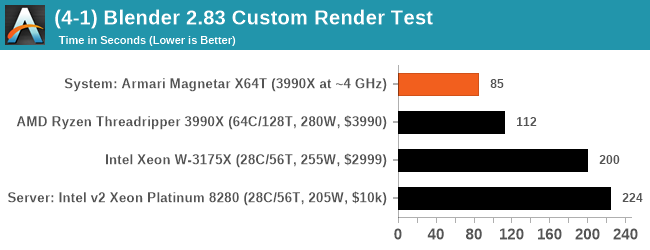
Over the standard Threadripper system, the X64T is around 32% faster in our Blender scene.
Corona 1.3: Link
Corona is billed as a popular high-performance photorealistic rendering engine for 3ds Max, with development for Cinema 4D support as well. In order to promote the software, the developers produced a downloadable benchmark on the 1.3 version of the software, with a ray-traced scene involving a military vehicle and a lot of foliage. The software does multiple passes, calculating the scene, geometry, preconditioning and rendering, with performance measured in the time to finish the benchmark (the official metric used on their website) or in rays per second (the metric we use to offer a more linear scale).
The standard benchmark provided by Corona is interface driven: the scene is calculated and displayed in front of the user, with the ability to upload the result to their online database. We got in contact with the developers, who provided us with a non-interface version that allowed for command-line entry and retrieval of the results very easily. We loop around the benchmark five times, waiting 60 seconds between each, and taking an overall average. The time to run this benchmark can be around 10 minutes on a Core i9, up to over an hour on a quad-core 2014 AMD processor or dual-core Pentium.
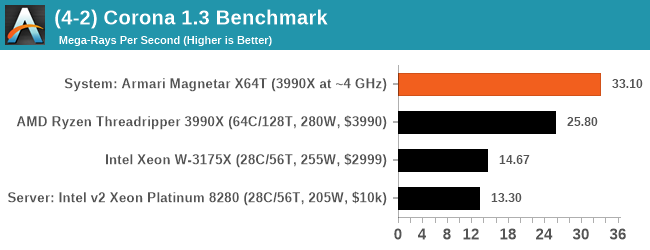
Corona typically scales very well with core count and frequency, and here the X64T has a 28% lead over a stock 3990X.
V-Ray: Link
We have a couple of renderers and ray tracers in our suite already, however V-Ray’s benchmark came through for a requested benchmark enough for us to roll it into our suite. Built by ChaosGroup, V-Ray is a 3D rendering package compatible with a number of popular commercial imaging applications, such as 3ds Max, Maya, Undreal, Cinema 4D, and Blender.
We run the standard standalone benchmark application, but in an automated fashion to pull out the result in the form of kilosamples/second. We run the test six times and take an average of the valid results.
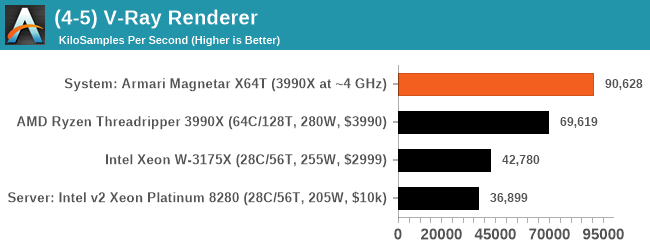
Similarly, the X64T has a 30% performance gain.
Cinebench R20: Link
Another common stable of a benchmark suite is Cinebench. Based on Cinema4D, Cinebench is a purpose built benchmark machine that renders a scene with both single and multi-threaded options. The scene is identical in both cases. The R20 version means that it targets Cinema 4D R20, a slightly older version of the software which is currently on version R21. Cinebench R20 was launched given that the R15 version had been out a long time, and despite the difference between the benchmark and the latest version of the software on which it is based, Cinebench results are often quoted a lot in marketing materials.
Results for Cinebench R20 are not comparable to R15 or older, because both the scene being used is different, but also the updates in the code bath. The results are output as a score from the software, which is directly proportional to the time taken. Using the benchmark flags for single CPU and multi-CPU workloads, we run the software from the command line which opens the test, runs it, and dumps the result into the console which is redirected to a text file. The test is repeated for 10 minutes for both ST and MT, and then the runs averaged.
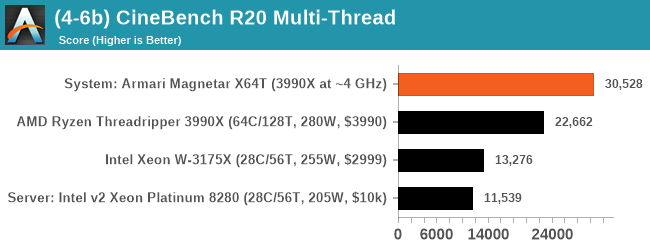
Cinebench go brrrr. I will never get tired of a quick R20 run like this, at around 15 seconds for the X64T. Performance is +35% over the stock 3990X.



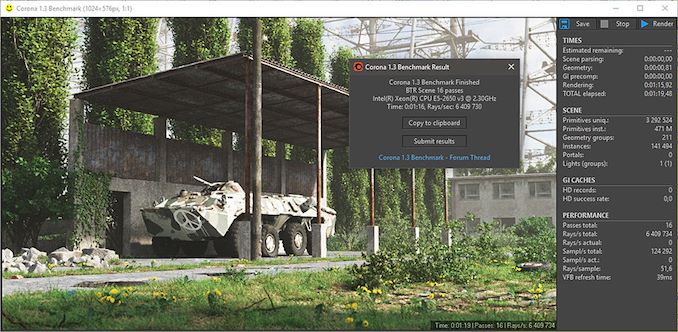










96 Comments
View All Comments
Spunjji - Friday, September 11, 2020 - link
There's nothing more sad than a lack of imagination.Everett F Sargent - Wednesday, September 9, 2020 - link
"Unfortunately due to how quickly this system was rebuilt for this review, the system I was sent was using DDR4-3200 at CL20, as some of the original memory was accidentally splashed with coolant, and Armari wanted to ensure I wouldn’t have any issues with the system."Unfortunately, they could not give one of these systems. In fact, they would have to give me $15K and this system, call it a warranty in reverse. :)
PeachNCream - Thursday, September 10, 2020 - link
That's the sort of trouble you have with using a little company like this as a supplier. They toss together shoddy bits and pieces because they don't retain proper inventory to support builds (and likely cannot afford to do so) and then for press-related reviews, they make absolutely sure there will not be issues with stability. Can we be certain they take the same care with hardware sold to non-journalist buyers or do those customers get the coolant-soaked memory and less stability testing? Who ensures there is adequate quality control in a smaller system builder like this?Chasing so-called "world records" in benchmarks in the hopes of increasing productivity by purchasing little-builder-overclocked hardware is asking to shoot your own business operation in the foot when the hardware fails. I would be very reluctant to trust my company's workload on out-of-spec computers cobbled together by a company that can't even be bothered to keep coolant fluids off the memory.
Ian Cutress - Thursday, September 10, 2020 - link
I received this system three or four days ago - I wasn't even in contact with the company a week ago. I suggested a review if a system was ready, and so they scrambled to action. Obviously they weren't going to send me a system that a customer had already ordered, delaying someone with a financial contract, and so they pulled out the system they built for the record and wanted re-test and update so I had the latest components. Best laid plans and all that, combined with a quick turn-around requirement, might lend more readily to non-ideal situations, but given what was done in that time (I was told that included a couple of engineers 7am-11pm the day before), it was actually very well executed.Spunjji - Friday, September 11, 2020 - link
"...by a company that can't even be bothered to keep coolant fluids off the memory."God forbid you ever see what goes on in the large system integrators' build rooms..!
Accidents happen, it's how they're dealt with that marks a bad supplier from a good one. "Something went wrong and we had to alter the spec" is infinitely better than "Oh well, the fluid's mostly inert, bung the RAM in and hope it works and blame the customer if it goes wrong."
Arutius - Friday, September 11, 2020 - link
I applaud this Company for its honesty and hustle. They are a small organization that cares about what they do. They appreciated Ian being available to them as a small business and are thankful for the exposure. Many readers here work in large organizations and have no appreciation for the real-world stress ( what is the balance of the checkbook today and where will we be in 1 month for cash and sales) on small businesses in this hyper-competitive atmosphere. Try sitting in the chair of the person who personally values each customer, who without they are shortly destined to fail.MrVibrato - Thursday, September 10, 2020 - link
Yeah, curiously they couldn't replace the "splashed" memory with modules of the same type. There are a small company and i don't expect them to have big inventory. If they don't have stock of these memory modules for at least two or three rigs like these, it tells me this is a cash-strapped operation that probably pays part orders from the advance payments from customers ordering one of their systems. And such vendors are always a major head-ache, because you pay for the system and then you wait and wait and don't get your ordered goods because the vendor struggles to place some order for some component with some supplier, not to mention what could happen if you need to do a RMA or warranty exchange through such a vendor. Mind you, i cannot tell with certainty that Armari is such a company. But this occurence would be a major red flag for me if i were shopping for a boutique workstation (as little sense as that would make, as Peach has explained already; and i would also add uncertainty about the ability to do quick-turnaround on-premises support/service, which larger vendors -while occassionally also being a bitch about- usually don't struggle with in and around large metropolitan areas wherever in the country)MrVibrato - Thursday, September 10, 2020 - link
Oh well, *There* should be *They*, and*it tells me this is a cash-strapped operation*
should be
*it tells me this is perhaps a cash-strapped operation*
MrVibrato - Thursday, September 10, 2020 - link
Never mind what i just wrote. I should have checked their website beforehand. Their product range seems to big and too broad to be one of those no-inventory boutique vendors. Mea culpa!Spunjji - Friday, September 11, 2020 - link
Perhaps check before leaving the big stinky comment full of bold assumptions on the small system integrator's offering?